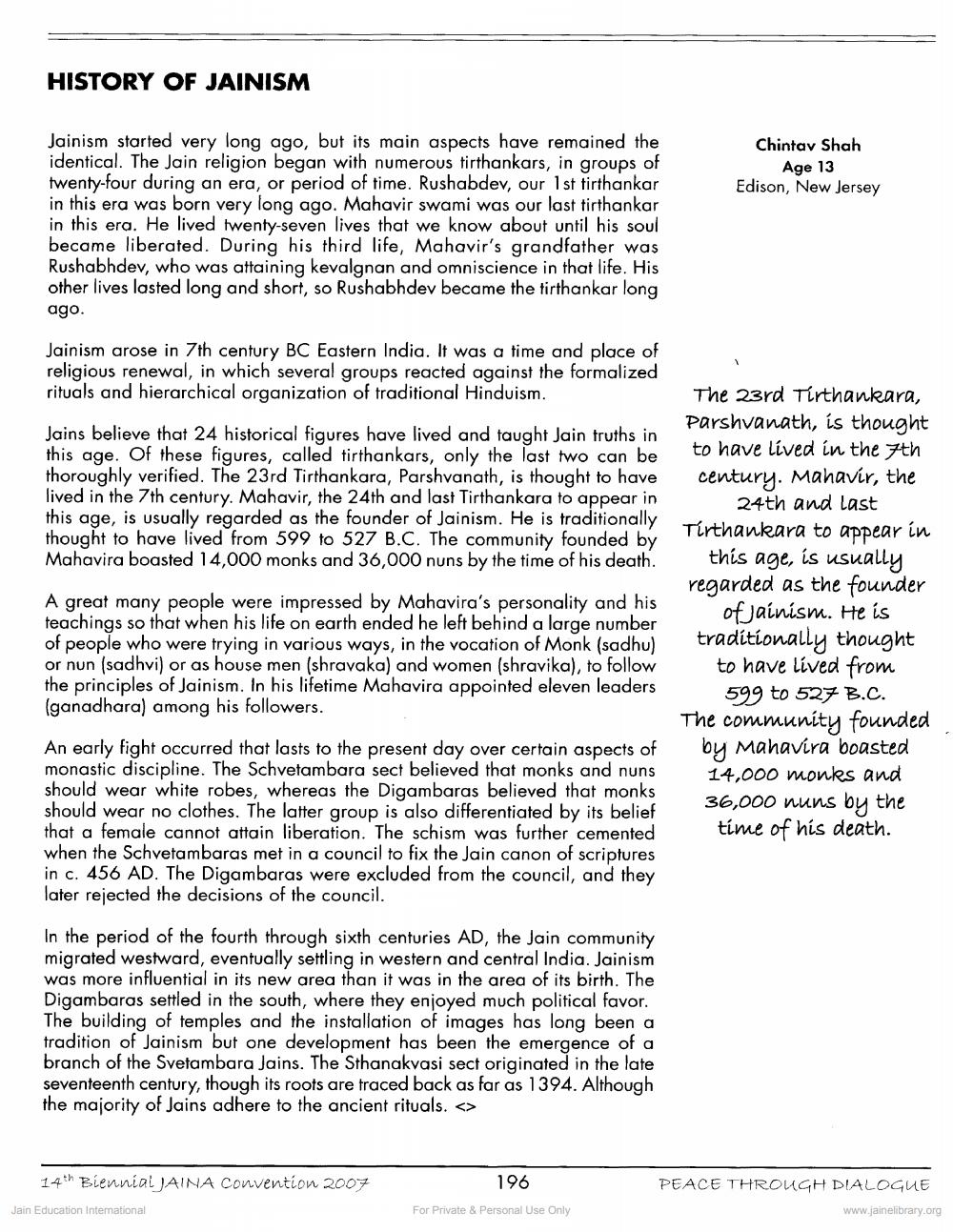________________
HISTORY OF JAINISM
Chintav Shah
Age 13 Edison, New Jersey
Jainism started very long ago, but its main aspects have remained the identical. The Jain religion began with numerous tirthankars, in groups of twenty-four during an era, or period of time. Rushabdev, our 1st tirthankar in this era was born very long ago. Mahavir swami was our last tirthankar in this era. He lived twenty-seven lives that we know about until his soul became liberated. During his third life, Mahavir's grandfather was Rushabhdev, who was attaining kevalgnan and omniscience in that life. His other lives lasted long and short, so Rushabhdev became the tirthankar long ago.
Jainism arose in 7th century BC Eastern India. It was a time and place of religious renewal, in which several groups reacted against the formalized rituals and hierarchical organization of traditional Hinduism.
Jains believe that 24 historical figures have lived and taught Jain truths in this age. Of these figures, called tirthankars, only the last two can be thoroughly verified. The 23rd Tirthankara, Parshvanath, is thought to have lived in the 7th century. Mahavir, the 24th and last Tirthankara to appear in this age, is usually regarded as the founder of Jainism. He is traditionally thought to have lived from 599 to 527 B.C. The community founded by Mahavira boasted 14,000 monks and 36,000 nuns by the time of his death.
A great many people were impressed by Mahavira's personality and his teachings so that when his life on earth ended he left behind a large number of people who were trying in various ways, in the vocation of Monk (sadhu) or nun (sadhvi) or as house men (shravaka) and women (shravika), to follow the principles of Jainism. In his lifetime Mahavira appointed eleven leaders (ganadhara) among his followers.
The 23rd Tirthankeara, Parshvanath, is thought to have lived in the 7th century. Mahavir, the
24th and last Tirthankara to appear in
this age, is usually regarded as the founder
of Jainism. He is traditionally thought to have lived from
599 to 527 B.C. The community founded by Mahavira boasted 14,000 monkes and 36,000 nuns by the time of his death.
An early fight occurred that lasts to the present day over certain aspects of monastic discipline. The Schvetambara sect believed that monks and nuns should wear white robes, whereas the Digambaras believed that monks should wear no clothes. The latter group is also differentiated by its belief that a female cannot attain liberation. The schism was further cemented when the Schvetambaras met in a council to fix the Jain canon of scriptures in c. 456 AD. The Digambaras were excluded from the council, and they later rejected the decisions of the council.
In the period of the fourth through sixth centuries AD, the Jain community migrated westward, eventually settling in western and central India. Jainism was more influential in its new area than it was in the area of its birth. The Digambaras settled in the south, where they enjoyed much political favor. The building of temples and the installation of images has long been a tradition of Jainism but one development has been the emergence of a branch of the Svetambara Jains. The Sthanakvasi sect originated in the late seventeenth century, though its roots are traced back as far as 1394. Although the majority of Jains adhere to the ancient rituals. <>
14th Biennial JAINA Convention 2007
196
PEACE THROUGH DIALOGUE
Jain Education Intemational
For Private & Personal Use Only
www.jainelibrary.org




